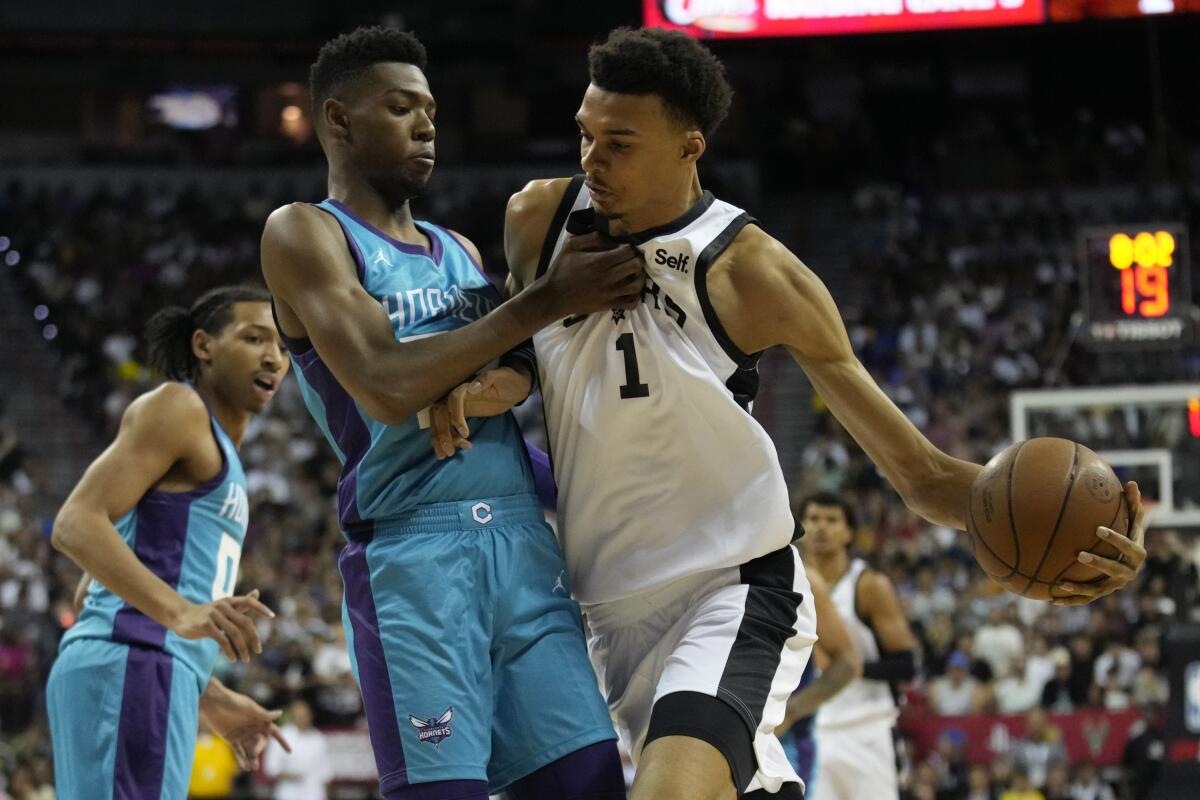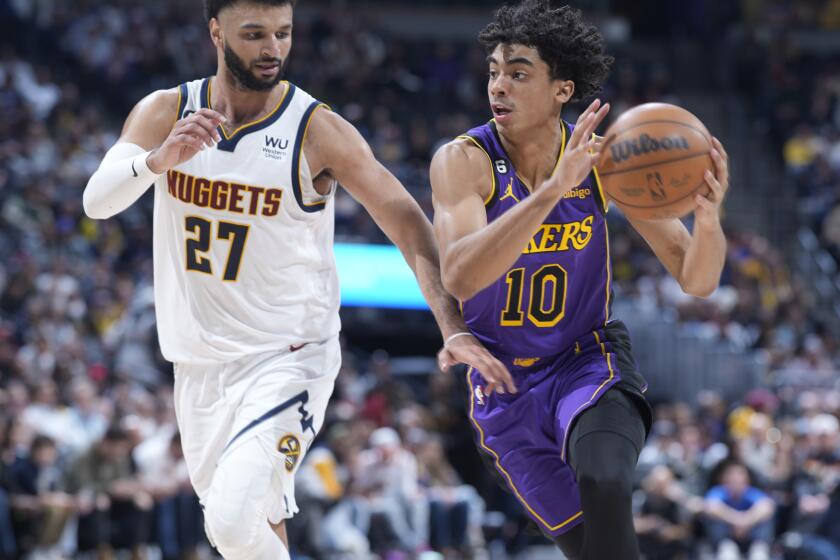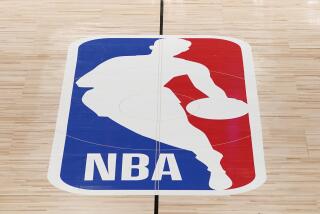NBA’s in-season tournament will only matter if teams make it an event

- Share via
LAS VEGAS — They all stood, the fans who sold out Thomas & Mack Center on Friday night, as Victor Wembanyama jogged onto the court. That the game meant nothing, that the rosters were made up mostly of dreamers whose hopes eventually will be unfulfilled, meant nothing.
They stood because this was a moment — the 7-foot-4, No. 1 overall pick taking the court as an NBA player for the first time.
It was an event — Kareem Abdul-Jabbar walked into the arena pregame to see the teenager who could become the NBA’s next great big man. Wembanyama struggled, looking very much like a tentative 19-year-old instead of anything close to a finished project.
Yet regardless of how Wembanyama played, it was an unquestioned success, the NBA giving people a reason to pay attention to its product in the middle of the summer.
The success Friday underscores the NBA’s big challenge moving forward, creating as many events as possible that feel special. It’s the biggest drawback to the prolonged NBA season — that the big moments aren’t predictable enough.
The league unveiled its latest crack at trying to solve this problem Saturday — an in-season tournament.
Scoot Henderson and Amen Thompson leave summer league game between Trail Blazers and Rockets because of injuries Friday night.
Over the course of four pool games and potentially three rounds of single-elimination games, all 30 teams will compete for the NBA Cup. Tournament games will be played every Tuesday and Friday in November (minus Election Day on Nov. 7). All games, minus the finals, will count for regular-season standings and statistical leaders.
Teams have been split into three groups per conference, not dissimilar to the World Cup draw, based on last year’s standings. The top two in each group, plus two wild-card teams, will advance to the single-elimination quarterfinals.
The Lakers will be in West Group A along with Memphis, Phoenix, Portland and Utah. The Clippers will be in West Group B with Dallas, Denver, Houston and New Orleans. West Group C is Golden State, Minnesota, Oklahoma City Sacramento and San Antonio.
The East pools are: Group A — Atlanta, Cleveland, Detroit, Indiana and Philadelphia; Group B — Charlotte, Miami, Milwaukee, New York and Washington; Group C — Boston, Brooklyn, Chicago, Orlando and Toronto.
The semifinals and finals will be played in Las Vegas on Dec. 7 and Dec. 9. In addition to winning the Cup, each player on the winning team will receive a $500,000 bonus.
The goal will be to make the games feel as different as possible — special uniforms, different court designs and broadcast graphics.
All of it is meant to create stakes early in the NBA season when the games feel like they matter the least.
Lakers wing Max Christie enters his second summer with the team looking confident and on the verge of becoming a rotation player.
Expect the change to be met with skepticism and, in some cases, mockery. It’ll be imperative that whoever wins the NBA Cup treats this like it’s important — it’s a must in making this work.
But consider what would happen if the Lakers were to win. For any organization with such a rich championship history, the NBA Cup would seem like just some gimmicky trinket. Imagine trying to hang a banner for that in the rafters. Another pitfall could be if a team such as the Clippers were to win. With no championships in its history, if the team were to treat the Cup with a banner, it would be easy ammunition for people looking to mock them.
The NBA is hardly the first sports league to try something like this. The NHL took games into baseball stadiums. Major League Baseball took a game to a cornfield in Iowa. The MLS and Liga MX are working together to create a continental competition.
Other innovations, most famously the NBA’s switch to a synthetic leather ball in 2005, have flopped. By December, the league switched back to leather. The NBA consistently has tinkered with its All-Star weekend, a player-led draft and target scoring the latest tweaks.
The NBA explored rule changes for the in-season tournament games with a target score being the most realistic option. Though once the league settled on keeping tournament games as part of the regular-season schedule, that kind of experimentation wouldn’t be possible.
Will fans be more interested in these games if all but the championship ones are special, mostly, in name only? The NBA thinks it can still win them over.
Finding ways to add big moments, even if they’re more contrived than the organic buzz in Las Vegas for Wembanyama’s debut, is a necessary part of the NBA’s future.
The in-season tournament will be the next innovation. And whether it works or flops, it won’t be the last.
More to Read
Go beyond the scoreboard
Get the latest on L.A.'s teams in the daily Sports Report newsletter.
You may occasionally receive promotional content from the Los Angeles Times.













